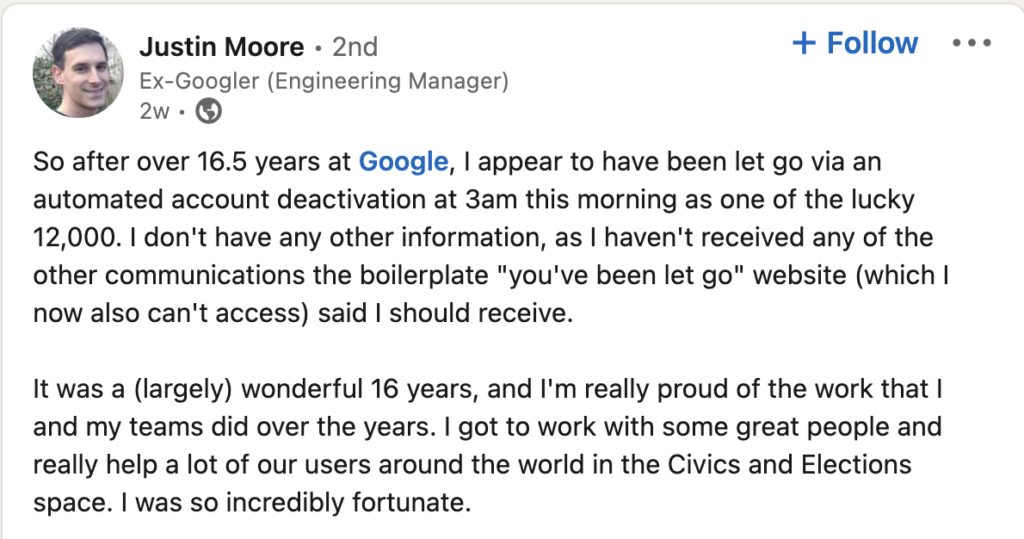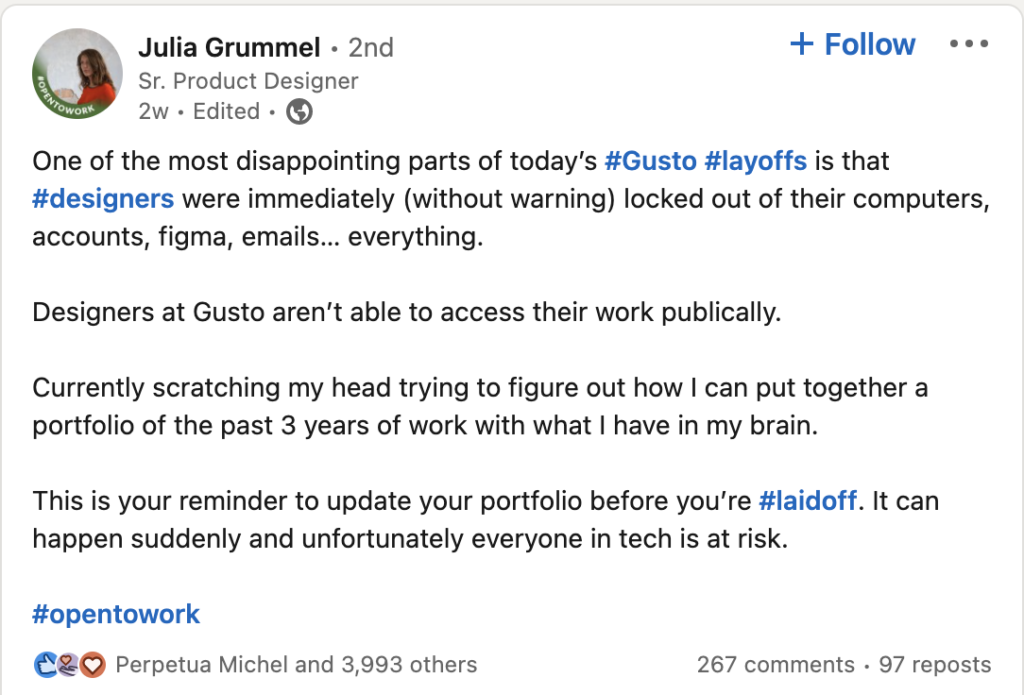In this post, you’ll learn 3 ways to build a portfolio that’ll make you recession proof.
The tech layoffs caught a lot of employees off guard.
The volume. The marquee names affected.
But how they happened is the most shocking.
People went to the office. Or they tried to sign in. Only to find they were locked out. Zero access to all their intellectual property on hard drives, on the cloud, and buried across emails.
Didn’t matter if you were there for 2 months or 12 years. Everyone was treated the same.


You have less control over your exit than you think.
Most people handle this uncertainty in one of two ways:
One: they don’t handle it at all. They don’t worry about it until it’s too late.
In other words, they invested YEARS of their life at a company…
And have nothing to show for it.


Two: they create a random collection of feedback and metrics, with no idea how to action it.
Collecting something is better than nothing. But there’s a better way.
When you build your portfolio, start with the outcome in mind.
There are three outcomes to build for:
- Interviews
- High performance
- Unwavering confidence
We’ll dig into all three:
1/ Interviews
Interviews are your time to demonstrate your skill and experience.
For most of my professional career, I didn’t know “how” to use this time in a meaningful way.
Then my former manager, Sara Caldwell, introduced me to the STAR method.
That was a MAJOR unlock.
The STAR method breaks down the outcome (demonstration of skills/experience) into four specific inputs:
- Specific situation you encountered
- Task you need to solve
- Action you took
- Result you drove
With the outcome in mind, you know the inputs you need to track.
You can collect these inputs from any work you perform: projects, launches, campaigns, revenue generated, customers helped, etc.
Note: I don’t feel strongly about using this particular framework.
Use whatever works for you.
It’s the idea that matters:
Collect inputs with the outcomes in mind.
2/ High performance
What I mean by high performance:
The ability to get 10x done in 1/2 the time.
We all know someone who embodies this:
In the time it takes you to create one measly presentation on your Q1 strategy…
- They produced multiple high-quality strategy docs, decks, and PRDs…
- While replying immediately to emails and Slacks…
- AND pick up their kids from daycare everyday.
Their secret?
They collect and deploy reusable components so they never start from scratch.
Reusable components are the intellectual products you create in your everyday work:
- Copy
- Notes
- Structure
- Processes
…that you can adapt and use over and over again.
In marketing parlance, it’s your personal swipe file.
For designers, this is the component library of your career.
- Reusable components include things like:
- Competitive analysis template
- Discovery interview questions
- Experimentation frameworks
- Investor update decks
- Quantitative models
- Job descriptions
- GTM checklists
Building your library of reusable components is simple.
Each time you build an asset, ask yourself:
“Will I use this again in the future?”
If the answer is yes, save a copy in your personal files.
Do this in any non-work account (e.g. Gdocs, Notion, Notes).
Include “Template” or “Component” in the title so you easily find it.
By building your library of reusable components, you’ll streamline workflows and save time.
Others will start to wonder:
“What’s your secret?”
3/ Unwavering confidence
There are 2 types of confidence. The first is built on affirmations, optimism and rainbows. Its close cousin is delusion.
The second type is built on repetition and results.
This second type is the outcome we seek.
The inputs?
- Positive team feedback
- Testimonials
- Quotes
- Wins
You can collect these inputs in a single “brag” document of sorts. I copy them to my daily notes. For emails, I use a simple label (“goodemail”) which makes it easy to resurface.
In their raw state, these inputs are difficult to use. You wouldn’t include them verbatim in a resume or cover letter.
Instead, use them as inspiration you can shape and mold. Some ideas:
- Ideas for your interview questions
- Get LinkedIn recommendations
- Personal website testimonials
- Identify your strengths
- Motivation boosts
Conclusion
Do not invest years of your life at a company and have nothing to show for it.
Build your portfolio with the outcomes in mind:
- Interviews
- High performance
- Unwavering confidence
When you alter your mindset and treat your 9-5 work as an investment in yourself, your daily work takes on new meaning.
Your incentives are tightly aligned with the incentives of the company.
The hours invested, hard work, and late nights become win-wins.
